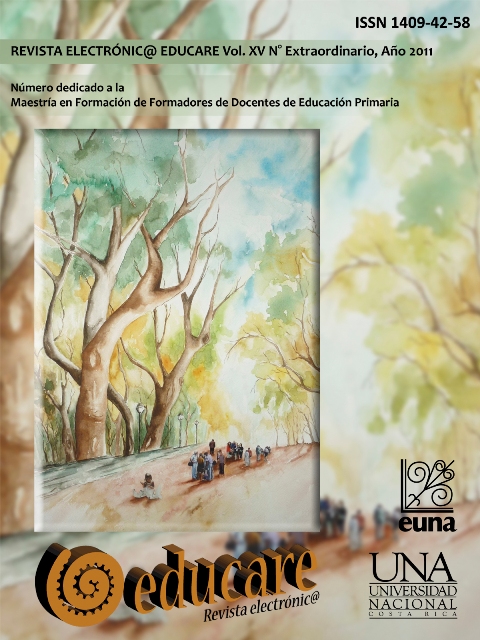Educational Inclusion in the Regular Classroom: an Asperger Syndrome Case
DOI:
https://doi.org/10.15359/ree.15-Ext.3Keywords:
Inclusive education, inclusive schools, social disability, Asperger’s SyndromeAbstract
The following paper resulted from the final research project conducted for my Master’s Degree in Teacher Training for Teachers of Primary Education (1st – 6th grade of the Basic General Education). This research project was conducted under the supervision of the Rural Education Division of the Center for Research and Teaching in Education (CIDE-UNA, Spanish acronym), in coordination with the Central America Educational and Cultural Coordination (CECC). The research is qualitative with an interpretative approach. Our main objective was to analyze the process of inclusive education in the regular classroom for a person with Asperger’s Syndrome, defined as a type of social impairment. The case study method was used in this research, as it allows a deeper study. A girl was chosen from a public school in an urban area of San José, Costa Rica. Three techniques were used to obtain information: interviews, questionnaires and documentation (personal file, behavior record, and psychological assessment) related to the girl with Asperger. The triangulation of sources was used as a method of analysis. The conclusion of the project was that regular schools may have children miss-diagnosed with Asperger’s Syndrome, and that our schools are still far from achieving inclusive education, but efforts are being made to achieve it. For a more opportune intervention, some recommendations based on this study were provided to the family and the school of the girl with Asperger.
References
Ainscow, M. (2001). Desarrollo de escuelas inclusivas. Ideas propuestas y experiencias para
mejorar las instituciones escolares. Madrid: Narcea de Ediciones.
Artavia, J. (2005). Actitudes de las docentes hacia el apoyo académico que requieren los estudiantes
con necesidades educativas específicas. Revista Pensamiento Actual, 5(6), 61-70.
Autism Society of America. (2004). El síndrome de Asperger. Recuperado de http://www.ct-asrc.
org/PDF/spanish2.pdf
Delgado, W. (2007). Inclusión: principio de calidad educativa desde la perspectiva del desarrollo
humano. Revista Educación, 31(2), 45-58.
Maristany, M. (2002). El alumno con síndrome de Asperger en la escuela primaria. Asociación
Asérger Argentina. Recuperado de http://www.asperger.org.ar/index.php?option=com_
content&view=article&id=60
Martin, P. (2006). El síndrome de Asperger ¿Excentricidad o discapacidad social? Madrid:
Alianza Editorial.
Muñoz. V. [Relator principal ]. (2007). El derecho a la educación de las personas con discapacidades
(Informe A/HRC/4/29). Recuperado de www.conadis.salud.gob.mx/descargas/
pdf/07VernorMunozONU.pdf
Stainback, S. y Stainback, W. (2004). Aulas inclusivas. Un nuevo modo de enfocar y vivir el currí-
culo. Madrid: Narcea de Ediciones. Recuperado de http://books.google.com/books?id=36TU
qoSh3cC&pg=PA5&hl=es&source=gbs_selected_pages&cad=3#v=onepage&q=porque&f
=false
Downloads
Published
How to Cite
Issue
Section
License
1. In case the submitted paper is accepted for publication, the author(s) FREELY, COSTLESS, EXCLUSIVELY AND FOR AN INDEFINITE TERM transfer copyrights and patrimonial rights to Universidad Nacional (UNA, Costa Rica). For more details check the Originality Statement and Copyright Transfer Agreement
2. REUTILIZATION RIGHTS: UNA authorizes authors to use, for any purpose (among them selfarchiving or autoarchiving) and to publish in the Internet in any electronic site, the paper´'s final version, both approved and published (post print), as long as it is done with a non commercial purpose, does not generate derivates without previous consentment and recognizes both publisher's name and authorship.
3. The submission and possible publication of the paper in the Educare Electronic Journal is ruled by the Journal’s editorial policies, the institutional rules of Universidad Nacional and the laws of the Republic of Costa Rica. Additionally, any possible difference of opinion or future dispute shall be settled in accordance with the mechanisms of Alternative Dispute Resolution and the Costa Rican Jurisdiction.
4. In all cases, it is understood that the opinions issued are those of the authors and do not necessarily reflect the position and opinion of Educare, CIDE or Universidad Nacional, Costa Rica. It is also understood that, in the exercise of academic freedom, the authors have carried out a rogorous scientific-academic process of research, reflection and argumentation thar lays within the thematic scope of interest of the Journal.
5. The papers published by Educare Electronic Journal use a Creative Commons License:














 The articles published by Educare Electronic Journal can be shared with a Creative Commons License:
The articles published by Educare Electronic Journal can be shared with a Creative Commons License: 



